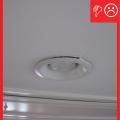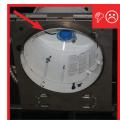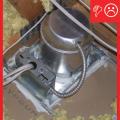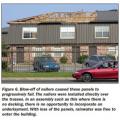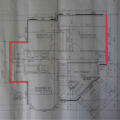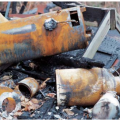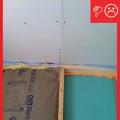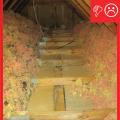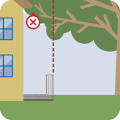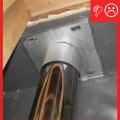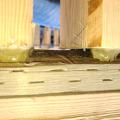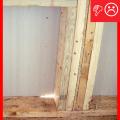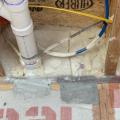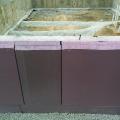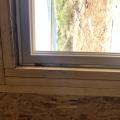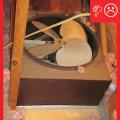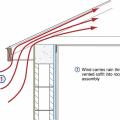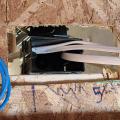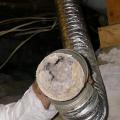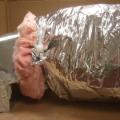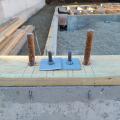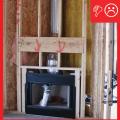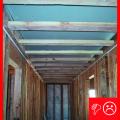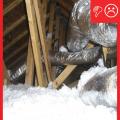Showing results 4901 - 4950 of 4973
Wrong – This multi family building appears to be done in traditional southwest architecture but the lack of useful overhangs, dark colored walls, and lack of tinting on windows will result in significant solar heat gain.
Wrong – This roof has no sheathing, when the metal panels blew off there was no secondary protection
Wrong – This roof membrane on a low slope roof is fluttering and may fail because it is not fully adhered and deck seams below are not sealed, allowing air to leak up into the assembly while the membrane is pulled up due to negative pressures from wind
Wrong – This second-story floor plan has red lines that indicate openings from the attic into the interstitial floor space
Wrong – This standard air vent has become blocked by flood debris and is located at the top of the foundation wall; it should not be used as a flood vent
Wrong – This vented crawlspace has standing water because steps were not taken to address site conditions that led to bulk water flow into the crawlspace
Wrong – This water heater was not braced; it fell during an earthquake and ruptured the gas line causing a house fire.
Wrong – Tree branches close to the house are prone to spreading crown fires to the house; the tree should be trimmed so that branches are at least 10 feet back from the red dashed line indicating the deck railing of the house.
Wrong – Two combustion appliances are sharing a flue which could lead to backdrafting if one appliance is updated to a direct vent appliance and disconnected from shared chimney.
Wrong – When insulated sheathing is installed correctly, you should not see daylight. Nail holes were also left unplugged.
Wrong – When insulating with spray foam, care should be taken to completely fill areas around piping and other penetrations to avoid leaving air gaps.
Wrong – When more than one layer of insulation is installed, the seams should be staggered to discourage ground water from reaching the foundation wall.
Wrong – Where possible, design walls and specify window sizes and placement to minimize the use of studs around windows; and seal all wood-to-wood seams to minimize air leakage through walls.
Wrong – Whole house fan installed with holes in surrounding platform that need to be air sealed
Wrong – Wind-driven rain and wildfire embers can enter an attic through the soffit vents.
Wrong – Window not protected and failed due to windborne debris in hurricane force winds.
Wrong –Best practice solid air barrier material was not used behind the shower surround.
Wrong –Excessive length and a vertical angle on this dryer duct reduced air flow allowing the dryer duct to become completely clogged with dryer lint
Wrong –The gate that was attached to the garage at the corner ignited and led the fire to the home, causing the damage seen here.
Wrong- A tie strap should not be used over the duct outer liner because it can compress the insulation. Tuck in the fibrous insulation and seal the outer liner to the connecting duct with mastic or foil tape (Steven Winter Associates 2013).
Wrong-The home was pulled off its masonry pier foundation during a coastal flood due to inadequate pier-to-beam connections.
Wrong-These masonry pier foundations were twisted and displaced by coastal storm surges in Long Beach, Mississippi.
Wrong: Closed-cell spray foam roof insulation was not thick enough to meet IRC levels so the foam surface is colder than the dew point of the interior air and condensation formed on surface of the foam
Wrong: Drywall does not extend beyond chase wall framing and is unsealed in a hallway dropped ceiling chase
Wrong: Drywall does not extend beyond the top plate of the interior walls. This installation has the potential for leakage at the sides where the ducts penetrate the side walls of the chase
Wrong: Ducts are held above the ceiling plane with strapping to provide a good angle into top-entry boots. Once the ceiling insulation is added, this duct will protrude from the ceiling insulation and will not be buried
Wrong: Ducts are held from the rafters with strapping and a large beam prevents ducts from properly lying on the ceiling plane
Wrong: Ducts are not laid across the lower truss cords or ceiling, but are hung from the rafters by straps. As a result, ductwork is not buried
Wrong: Ductwork is not fully encapsulated with ccSPF insulation. The duct jacket is still fully visible at sections of the duct
Wrong: Electrical components were installed near ground level and are likely to be flood damaged.

